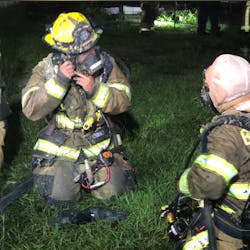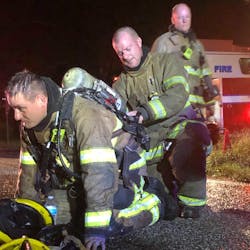During the third week of June, there is a joint national event between the International Association of Fire Chiefs and the National Volunteer Fire Council called the Firefighter Safety Stand Down. During this annual event, fire and EMS departments across the nation are encouraged to suspend all non-essential activities to focus on education and training related to firefighter safety.
The goal is to reduce firefighter injuries and deaths, and this year the focus was on roadway safety.
In the June issue of Firehouse, the "This Month in Fire History" section had a list of deaths. According to Firehouse, and going back to 1904, 1,276 people have died in fire-related incidents in the month of June, including 40 firefighters. This does not count all the firefighters, or the thousands of other civilians who died in their own homes in less spectacular headline-grabbing events.
The 40 firefighters who have died in June were each lost in a preventable event:
- In Boston in 1972, a building collapse during overhaul due to unapproved construction killed nine firefighters.
- In New York City in 2001, illegal propane tanks stored in a basement exploded during a fire, killing three firefighters.
- In 2007 in Charleston, SC, a fire killed nine firefighters in a warehouse that should have had a sprinkler system and had failed in adherence to fire codes.
- In 2013 in Yarnell, AZ, 19 hotshots died in a wildfire that, although naturally caused, underscores the challenges of the wildland-urban interface in relation to fire prevention and codes.
According to the 2018 NFPA report on firefighter fatalities in the U.S., on-duty firefighter deaths have been on a downward trajectory since 1977. Since 2010, however, those numbers appear to be more fluctuations than trending, with cardiac issues continuing to be the leading cause. The 2018 report listed eight firefighters who died in vehicle crashes. Also, according to the report, firefighters killed in traffic accidents while responding to or returning from alarms have averaged below 14 deaths in the last decade, and less than 12 over the last five years.
The NFPA is quoted in this report as follows: “There has been a marked reduction in both crash deaths and cardiac related deaths while responding to or returning from alarms over the past 40 years.” (pg. 5). In contrast, according to this report, 25 firefighters died while operating at fires and explosions. While this is just slightly below the decade average of 26, it is the highest since 2013.
In 2019, nine fire/EMS personnel were struck and killed, according to the Emergency Responder Safety Institute.
Additionally, according to a 2019 USA Today report, firefighter suicides have surpassed on-duty deaths in the past five years, and according to the Firefighter Cancer Support Network, 61% of career firefighter line-of-duty deaths between 2001 and 2017 were caused by cancer. It can be argued that the rates of PTSD, suicide, and cancer can also be linked to fireground-related trauma and exposures.
Now let’s switch over to some statistics covering the civilians we're sworn to protect. According to the 2018 NFPA Fire Loss report, 3,655 civilians died in a fire, with 2,720 dying in their home—an increase of 8% and 3%, respectively, from 2017.
If you look at those statistics, they mirror that of firefighter deaths, with steady declines starting in 1977 turning to more of annual fluctuations starting in the late 1990s. However, NFPA research shows a disturbing trend not easily discernible simply by looking at graphs. According to a 2019 NFPA research report by Marty Ahrens, while civilian fire death numbers have been cut in half since 1980 (a goal of the America Burning Report), more people are dying in fires.
Expressed another way, while the overall number of fire deaths have declined, the rate of deaths occurring in fires have actually increased by 6% since the 1980s.
The moral to this story is that fire and the fireground are killing more firefighters than traffic related incidents, and killing more civilians, of whose life and property we swore to protect, at a rate higher than four decades ago. It would serve us well to acknowledge that when it comes to preventing death and injury in our profession we are at an impasse. Without a new approach or different thought process, needless loss of life will continue.
So I contend that if we reduce the number of fires, or reduce its ability grow and spread, we may again see a downward trajectory in the trending numbers.
How to accomplish this:
- Acknowledge that when firefighters put their mind to something, they will accomplish it. The 1973 America Burning Report was a landmark document from which all our modern fire service roots sprout. The goal was a reduction of fire deaths, injuries and property loss, which has been achieved. Since the Everyone Goes Home project started in 2004 with aggressive initiatives that addressed the culture of the fire service, there has been an overall reduction in firefighter deaths. We can do it!
- Continue to do what we are doing for firefighter safety. By continuing to address all causes of firefighter deaths with safety stand downs, training, and research, we will continue to save lives and keep firefighter fatality numbers low. This should continue.
- Stop ignoring the obvious. More firefighters are dying on the fireground, either directly from the fire itself or the impacts from the response such as cardiac events, cancer or suicides. Even in relation to traffic accidents, according to the NFPA report, 25% of the deaths occurred while responding to a fire.
- Continue addressing prevention and community risk reduction topics. Our firefighters need to be equally educated on leading causes of fires and the prevention of them as they are on wearing seat belts and safely operating emergency vehicles. They need to be educated on the effectiveness of sprinkler systems and fire codes as it relates to overall firefighter safety, health, and fitness so they can participate in their application along with community discussions and debates for their adoption, use, and enforcement.
When we look at our history of firefighter safety initiatives, you can see we go all-out with health and fitness education (ability to fight the fire), research on equipment and gear (get closer to the fire and extinguish efficiently), research on fire dynamics (better strategy and tactics), and it’s all working!! Good stuff! But we largely ignore the one true means to keep firefighters safe: prevention of fire.
Need proof? Look at your local state conference programs on classes being offered and compare/contrast the list of classes to those mentioned (fitness, operations) with those dealing with prevention and CRR. Pick up a magazine, look at the articles, and do the same. Those leading these conferences and publishing these magazines will understandably state they do so in order to sell. It's simple supply and demand, and you can’t sell what people will not buy.
And when it comes to firefighter safety and our culture, that is the problem. So I ask, when it comes to their safety, do firefighters really get it? Are we effectively leading the fire service to a complete safety package or just selling sporty after-event or reactionary products? And by doing so, are we actually feeding and growing an underlying unsafe culture for us and those we have sworn to protect?
About the Author

Daniel Byrne
DANIEL BYRNE is a community support officer for the Burton Fire District, Beaufort County, SC, and a retired assistant fire chief of training for the Georgia Air National Guard 165th Fire Department. A third-generation firefighter, he holds an associate degree and a bachelor’s degree in fire science as well as a master’s degree in public administration and disaster management. Byrne is an alumnus of the National Fire Academy. He received state and local awards for public relations and educational programs as well as community partnerships and served as a conference presenter and keynote speaker.

